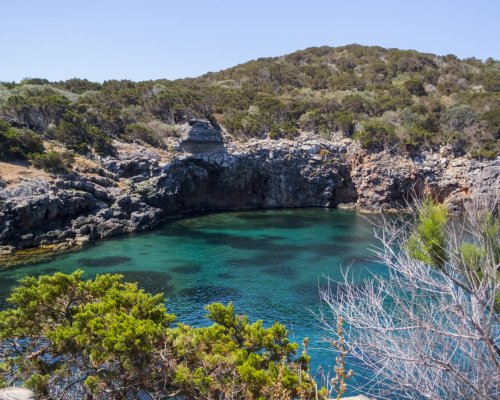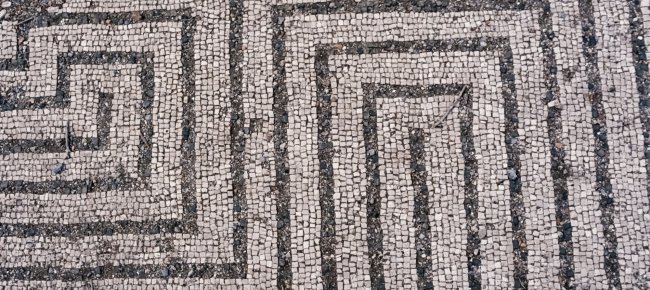


Nature and archaeology on the half-moon island
Floating in the blue of the Mediterranean, across from Monte Argentario, the island of Giannutri is a little natural paradise protected by the Archipelago Toscano National Park. Bays of clear water, cliffs and caves that go deep into the sea, strips of chalky earth which in the spring explode with the colours of Euphorbia, the smell of Mediterranean scrub: all of it an invitation to go walking.
Trekking enthusiastswill be able to do it in a single day and in the warmer season they can also swim in the crystalline waters. As for lovers of archaeological digs, Giannutri offers the well-preserved ruins of an ancient Roman villa, only recently open to the public, which faces out onto the sea; birdwatchers, meanwhile, will soon understand why Giannutri is known as the island of gulls. These majestic flyers nest here in great numbers, amounting to the most important colony in the southern part of the Tuscan Archipelago.
Precisely because of its delicate ecosystem, access to certain areas of the island is regulated so as to preserve its beauty, but confronting these minor difficulties is certainly worthwhile for the sake of visiting the island that is shaped like a half-moon.
At the moment, the only freely walkable part of the path that crosses the island is the stretch from Cala Spalmatoio to Cala Maestra, while all the others can be taken in the company of a tourist guide.
Be aware, however, that the rules of access can change. It is therefore necessary, before going, to enquireat the Archipelago Toscano National Park (www.islepark.it), who will be able to supply up-to-date information on connections, on the possibility of doing the routes by yourselves or whether a guide is indeed necessary, and on the conditions of accessing the archaeological site of the Roman villa.
We disembark on Giannutri at Cala Spalmatoio, where traces of an ancient Roman port can be found. We start climbing up the small road that traverses the little town. Be advised that off-season there is just the one shop and it is not always open, so it is necessary to stock up on food and water before arriving on the island. We continue our walk until arriving at a crossroads, where we turn right in the direction of Punta San Francesco.
On this stretch, we climb to the Poggio del Cannone, where one normally finds one of island's biggest colonies of yellow-legged gulls. We then reach Punta San Francesco, from which we can gaze out over the crystalline seascape. We retrace our steps to the crossroads for Cala Spalmatoio, but rather than returning to the point of departure we move in the direction of Cala Maestra, until reaching the archaeological site of the Roman Villa Domitia.
Along with the natural beauty of the island, the villa is Giannutri's major attraction, whether for its location, looking directly out over the sea at Punta Scaletta, or for its state of preservation. It belonged to the wealthy Domitii Enobarbi family,who, as owners of Giannutri and the Isola del Giglio, built an important residential complex and seaport here beginning in the first century AD.
You can visit, if it is allowed, the buildings that comprise the villa: the little gate and the cistern for water, the storehouses and the slaves' quarters, the bedrooms of the family members and the baths, with painted walls and floor mosaics, partially intact to this day. Lastly, there is the villa's belvedere, a kind of balcony that overlooks the entire complex and from which rises a structure of granite columns and Corinthian capitals. The villa followed the slow decline of the Roman Empire and eventually fell into ruin, having been completely abandoned. The isolation of Giannutri meant that the villa was largely intact when it was unearthed in excavation projects in the 19th century.
We disembark on Giannutri at Cala Spalmatoio, where traces of an ancient Roman port can be found. We start climbing up the small road that traverses the little town. Be advised that off-season there is just the one shop and it is not always open, so it is necessary to stock up on food and water before arriving on the island. We continue our walk until arriving at a crossroads, where we turn right in the direction of Punta San Francesco.
On this stretch, we climb to the Poggio del Cannone, where one normally finds one of island's biggest colonies of yellow-legged gulls. We then reach Punta San Francesco, from which we can gaze out over the crystalline seascape. We retrace our steps to the crossroads for Cala Spalmatoio, but rather than returning to the point of departure we move in the direction of Cala Maestra, until reaching the archaeological site of the Roman Villa Domitia.
Along with the natural beauty of the island, the villa is Giannutri's major attraction, whether for its location, looking directly out over the sea at Punta Scaletta, or for its state of preservation. It belonged to the wealthy Domitii Enobarbi family,who, as owners of Giannutri and the Isola del Giglio, built an important residential complex and seaport here beginning in the first century AD.
You can visit, if it is allowed, the buildings that comprise the villa: the little gate and the cistern for water, the storehouses and the slaves' quarters, the bedrooms of the family members and the baths, with painted walls and floor mosaics, partially intact to this day. Lastly, there is the villa's belvedere, a kind of balcony that overlooks the entire complex and from which rises a structure of granite columns and Corinthian capitals. The villa followed the slow decline of the Roman Empire and eventually fell into ruin, having been completely abandoned. The isolation of Giannutri meant that the villa was largely intact when it was unearthed in excavation projects in the 19th century.




With the ancient ruins of the Villa Domitia and the view from Cala Maestra and Punta Scaletta still dazzling the eyes, we get back on the road. We retrace our steps back to the crossroads for CalaSpalmatoioand once again we turn right.
We plunge into the Mediterranean scrub, with all its colours and scents, walking with Mediterranean horizon as far as the eye can see. The path is wide, with gentle climbs and descents which you can negotiate without difficulty. The highest point, around ninety metres above sea level, is Poggio Capel Rosso, another important refuge and nesting-place for a significant colony of yellow-legged gulls, who make themselves heard with their unmistakable song.
From Poggio we descend until we reach the Capel Rosso Lighthouse. This is the wildest part of the coast, with cliffs that rise out of the sea and offer the spectacle of the so-called Grottoni, rock formations which arch in the sea, resulting in submarine caves.
From the lighthouse, you can enjoy the view of the cliffs and the Capel Rosso promontory, home to another important colony of yellow-legged gulls. From here we return to where we started.
With the ancient ruins of the Villa Domitia and the view from Cala Maestra and Punta Scaletta still dazzling the eyes, we get back on the road. We retrace our steps back to the crossroads for CalaSpalmatoioand once again we turn right.
We plunge into the Mediterranean scrub, with all its colours and scents, walking with Mediterranean horizon as far as the eye can see. The path is wide, with gentle climbs and descents which you can negotiate without difficulty. The highest point, around ninety metres above sea level, is Poggio Capel Rosso, another important refuge and nesting-place for a significant colony of yellow-legged gulls, who make themselves heard with their unmistakable song.
From Poggio we descend until we reach the Capel Rosso Lighthouse. This is the wildest part of the coast, with cliffs that rise out of the sea and offer the spectacle of the so-called Grottoni, rock formations which arch in the sea, resulting in submarine caves.
From the lighthouse, you can enjoy the view of the cliffs and the Capel Rosso promontory, home to another important colony of yellow-legged gulls. From here we return to where we started.